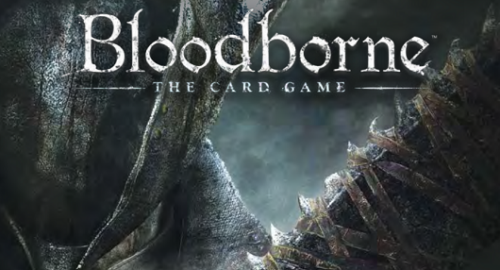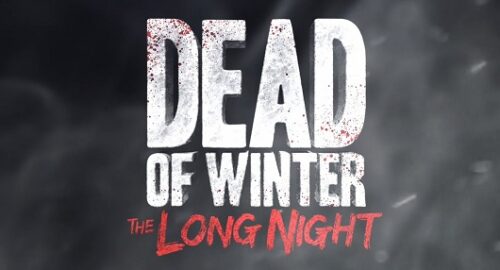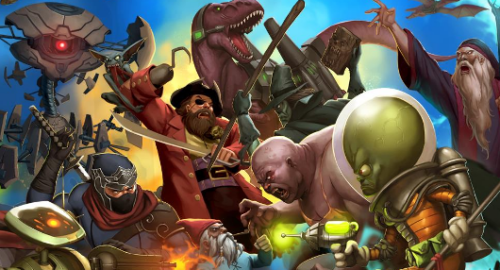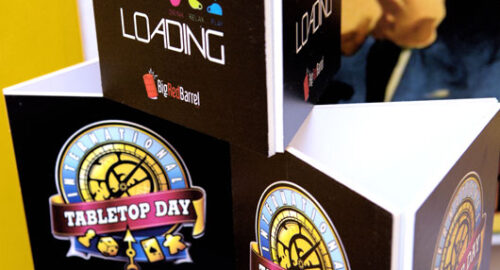UK Games Expo has always been a highlight of my board gaming year. Last year, I started a series called UK Games Expo Diaries where I would pick out some of the most interesting new games I had a chance to play on the day and write a small preview. Hopefully highlighting them for our readers to either check out if they are at the Expo or look them up online. This year I am very happy to continue this tradition as, once gain, there was an abundance of awesome board games to play at the expo.
These are the board games I had a chance to play on the first day of the expo:
Dice Forge
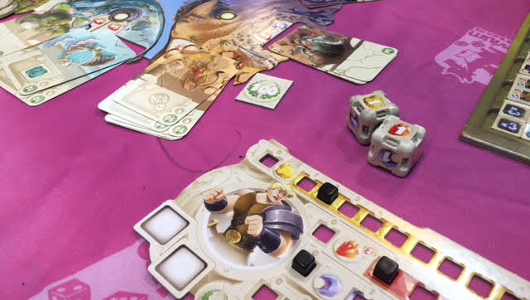
If there was such thing as a board game candy, Dice Forge would definitely qualify. It is so stunningly beautiful and every component is so well thought out, that you can’t help but want more of this dice goodness in your life. If you heard or played card building games before, then Dice Forge will be familiar to you. Except, this is a dice building game, as in you literally build your dice from beautiful plastic components that clip and fit onto a dice frame. Have I said ‘beautiful’ enough? BEAUTIFUL!
The rules of the game are also incredibly simple. Every player starts a round with identical die, which they roll on their turn and receive resources – gold or magical elements – in accordance with the roll outcome. A special track is used to note how many resources of each kind each player has. Following that, player can decide what to spend their resources on: they can either purchase cards that provide victory points and other special abilities, or they can spend their gold to upgrade the sides of their die with bigger and better values. The latter gives them a better chance of rolling more resources on the next turn. The game lasts nine rounds, after which the player with the most points win.
While these game mechanics are as straightforward as they get, the opportunities are vast. The decisions are simple – you either upgrade die or get victory points and extra abilities, yet balancing them out along with managing your resources, is what makes this game so strategic.
Dice Forge was my love at first sight and if you are on the show floor of UK Games Expo, I highly recommend that you check it out.
The Godfather: Carleone’s Empire
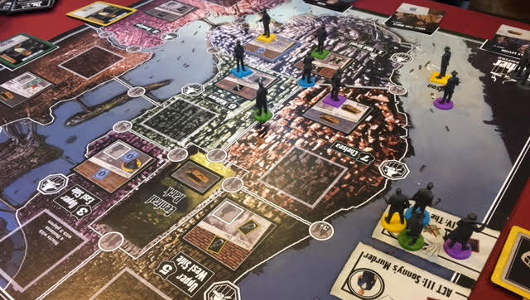
It is time to sleep with the fishes. If you think I am joking, The Godfather: Carleone’s Empire actually has a river on the game board and that is exactly where all assassinated thug figures go.
The Godfather: Carleone’s Empire is a relatively short, for this type of game, worker placement game. Each player takes control over a mafia family vying for dominance over New York. The players will deploy their meeples around the board to shake down businesses, assassinate opponents, scheme and launder money. This could have been just a game about mafia members fighting each other, but, I guess, if the Godfather licence is available, there is no harm in using it. It adds a flashy recognisable name and artwork with Marlon Brando front and centre. Otherwise, there are no close connections to the first movie which it is supposed to be based on, except that both are about mafia families fighting for control.
However, this is me nit-picking, because what I got to play of the game at UK Games Expo left me really intrigued. I like worker placement games and this one has solid mechanics, as well as plenty of opportunities to mess with your fellow players, which also speaks to my mischievous heart.
If that hasn’t peaked your interest, The Godfather: Carleone’s Empire was designed by Eric Lang, and this guys knows his stuff. I am looking forward to properly sinking in my teeth into this game and perfecting my turf warring skills.
Codenames Duet
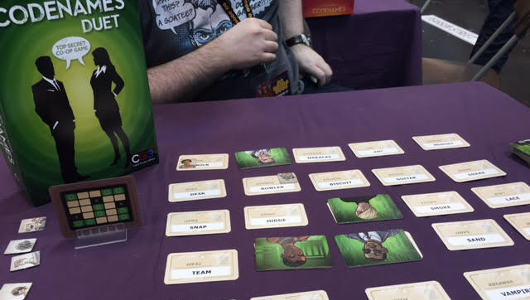
Codenames has always been one of my favourite party games. Simple, unimposing, it is a great little game for a group of people with a good balance between having fun and tickling your brain. Codename Pictures, another version of the game, is equally fun and possibly more approachable for younger players, who would be more enticed by interesting pictures than a grid of words. However, while the game is a lot of fun with a group, is better when played with a group, of at least four people, and even better with more. On many occasions I wished that there was a game variant or special rules for two player, and it seems that Vlaada Chvatil and Scot Eaton knew that too, because they came up with Codenames Duet.
All Codenames essentials are still there. You are still giving clues to your teammate using only one word and one number. There is still a grid of words or a grid of pictures (as Codenames Pictures can be substituted) in front of you, and some of those words are your agents, while others are bystanders or, worse, assassins. The difference is that now both players work together to find their agents on the grid and they are up against the clock (not a sandglass, luckily, but simply a finite number of turns). In addition there is also a separate campaign, which I didn’t get to play at the Expo, but is a welcome addition in my books.
Checkpoint Charlie
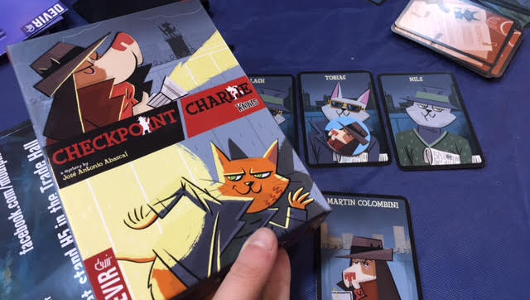
Checkpoint Charlie is a quick deduction bluffing game, where players take on a role of dog detectives to find a suspect, who is, of course, a cat. Each player has one clue, for example, whether it is a grey or a ginger cat, or if the cat is wearing a hat or not. However, none of the players have all the clues. As players go through the list of possible suspects, they can say whether that particular cat is a suspect from their clue. As the players get more information on the appearance of said feline suspect, they can venture a guess as to who is the true culprit. Whoever gets the most clues right gets a star! On the other side of the star there is a random number of points and the player with most points after three rounds wins.
Checkpoint Charlie has adorable artwork and is perfect for a quick social game. There are additional rules that add more strategy to the game, if required. I am not entirely sure if the game needs to have a random point distribution element, but that doesn’t at all spoil the fun.
Tournament at Camelot
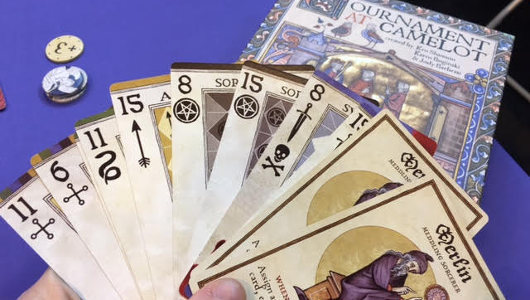
Who doesn’t like a bit of swords and sorcery in an Arthurian setting? That definitely sounds good to me! Tournament at Camelot is essentially backstabbing game of top trumps with beautiful stylised artwork. Players play as one of the Arthurian characters and their companions, fighting against each other in a melee tourney. The last sorcerer or knight standing wins the game.
This is a game that is better played with a larger group of people. I would say four and above, although there is a two player variant. While top trumps is hardly a revolutionary idea, it is the backstabbing and special powers that elevate the game and give it its own character.
Tournament at Camelot is fairly straightforward to play, but the game is littered with minute rules, some of which are not too clear, which bring the game down. However, as a quick, light strategy game, this would be a welcomed addition to a party game shelf and I can easily see a group of friends having a laugh while playing it.
Towers
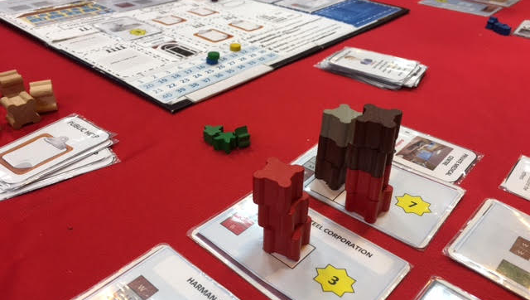
I can’t spend a day of UK Games Expo without heading to Playstest UK and trying out games that are still being developed and polished. This is a place where some true board game gems can be found, and I can’t recommend enough heading to Playtest UK section to see what they currently have on.
One of those gems in the making is Towers, a worker placement game about building – yes, you got it – towers! While this game has a lot of elements typical of the genre, there are also some interesting mechanics, that while not revolutionary, contribute well to the game. Resource management is a big part of it. I really like how resources are used overall, from how they are added to the playing table to how they are eventually used to build towers. The game has two major sets of rules: the blueprint rule and the permit rule which define how anything gets built. To build your tower, you have to follow the order outlined on the blueprint but only using materials specified on the permit. While these rules are rigid and restricting, there are plethora of cards that give a variety of actions that make the game more flexible and strategic.
Finally, I would like to add that the artwork above is still representative of the game in progress, and while there were a few minor things that needed tinkering, the game is already very good. I am really looking forward to a final look of Towers.
Dized
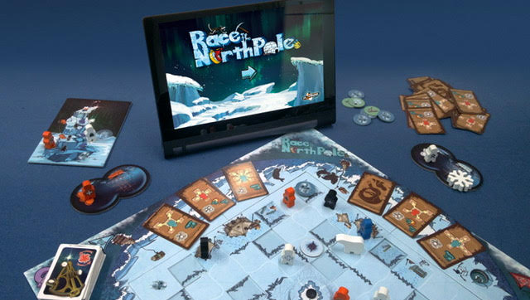
I confess, this is a cheat, because this isn’t a board game. However, Dized is a very interesting project in the making. It is an app that teaches board game rules to players. However, instead of tedious boring way of the board game rule books, Dized teaches board games through interactive tutorials, videos and voice overs. The idea of the app is that instead of spending half an hour studying the rule book when playing a new game, players can start playing straight away while the app explains the game as you go along. There is also a promise of easily searchable database for each title on the app with a comprehensive F.A.Q. section to which players can add new questions and answers.
As an idea this is exciting, especially as someone who runs a regular board game night and has had to on many occasions explain rules to others to save them from the odious task of going through the rulebook. With Dized, they could just load the app and follow the instructions.
However, the success of the project hinges on a few significant aspects. First of all, the app has to contain a comprehensive library of board games, including the classics, the new and the indies. The creators told me that this part is in hand and announcement of their library is incoming. Second of all, board games are learnt and explained in different ways. Some are better understood through doing a round or two to get a feel for the game play, while others need to tell gamers about some basic rules first, so the game can be played to its full potential with all its nuances. Therefore, the toolset for the designers on Dized has to be adaptable to many different playstyles and learning approaches. Again, I received the assurances from the Dized design team that they are very well aware of the challenges. Finally, we have the question of cost. While the app is promised to be free for users, with certain paywalls over specific functions, it will cost a pretty penny to create an interactive rule book with voiceover and music for any game. The more complicated the game is, the more coding, artwork and audio would have to be done. While, I am sure some of the bigger publishers would be more interested in this, I am not too sure that the indies will see enough of a payoff.
Having said that, the above is only my speculation and guesses. Dized is coming to Indiegogo in August and, I presume, the design team will be giving out more information closer to that time. Until then, I will be following this project with a great interest because it definitely has potential to be something really great.
This is it for the board gaming round up of day 1 of UK Games Expo. Let’s see what day 2 will have in store for us!

